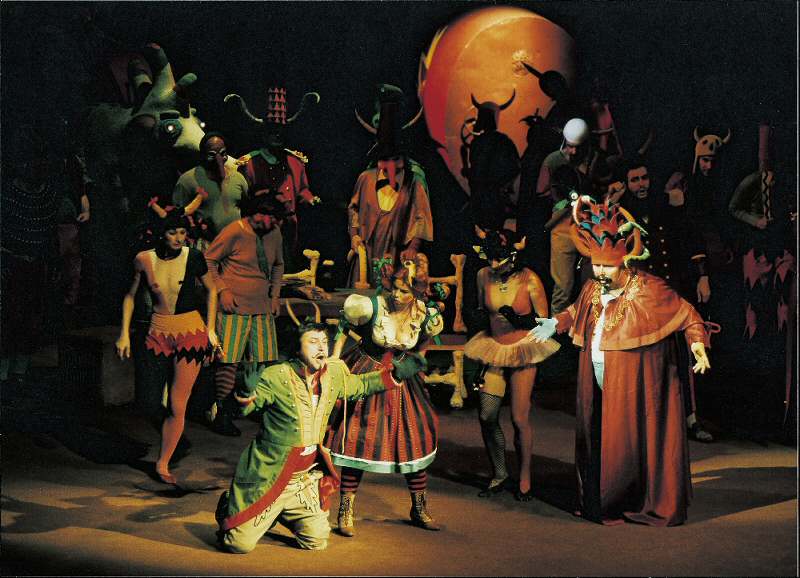 The Devil and Kate (Čert a Káča) is another not-so-often performed opera by Antonín Dvořák. It is based on a folk fairy-tale collected and written down by Božena Němcová about an energetic girl named Kate.
The Devil and Kate (Čert a Káča) is another not-so-often performed opera by Antonín Dvořák. It is based on a folk fairy-tale collected and written down by Božena Němcová about an energetic girl named Kate. Story:
The opera opens in a tavern, where a village celebration is taking place. Music is playing and everybody is dancing, but Jirka, the shepherd, has to go to work, or his master would fire him. Before he leaves, Kate and her mother turn up. Kate would like to find a husband, but nobody wants to dance with her, because she's cheeky and sharp-tongued. She says that she would marry even a devil. At that moment, the devil Marbuel enters the tavern, disguised as a huntsman. He had been sent by the lord of hell Lucifer to investigate whether the princess and steward have committed enough sins to be taken to hell. He wants to tease Kate and punish her a little for her sharp tongue, so he asks her to dance and proposes her to leave with him. When she agrees, he takes her to hell. Then Jirka returns, saying that his master had sent him to hell. When he hears what happened, he decides to save Kate.
The second act takes place in hell. Marbuel wanted to play a joke on Kate, but he made a terrible mistake; Kate refuses to get off his back, and with her temperament she turns all hell upside down. Jirka comes to rescue her, but in fact he's rescuing hell from Kate.
The princess has learnt that the devil is coming to take her to hell and she is sorry about the sins that she's committed. She begs Jirka to save her, so he tells Kate to hide in the palace to wait for the devil and catch him. When Marbuel comes, Jirka tells him that Kate is hiding there, and the devil flees in terror. The princess is immensely grateful to Jirka, promises to rule justly and abolish serfdom, rewards Kate, and appoints Jirka her councillor.
The overall musical style is dramatic, almost Wagnerian - there are not many arias, most of the time is filled with dialogs. The story flows quickly, it's not slowed down by many repetitions.
The Devil and Kate at the National Theatre:
The production you can see at the National Theatre usually at 11AM has the staging and costumes designed by the renown artist Adolf Born. The director Marián Chudovský decided to fully support the story. The time suggests it's not only for adults, but also for children, and they certainly won't get bored. Every single moment there's something happening on stage, at every point there's something to look at. And who would think that it's a second-rate performance would be mistaken; the bass-baritones Luděk Vele and František Zahradníček alternate as Marbuel, and if you're lucky, you can see the tenor Tomáš Černý as Jirka, even though Jaroslav Březina is a safe bet, too. Kateřina Jalovcová was the Kate and Jitka Svobodová was the princess on my evening, both sang nicely. Above the stage there are surtitles in English, so if you're in Prague when this opera is on, don't hesitate to go!
The environment of the opera is entirely Czech - the countryside tavern, the clothing, and especially the appearance of the devils. Actually, in Czech we have two words for devil, and they are not synonymous. The word "ďábel" has the meaning the closest to the English "devil". However, when you say "čert" (pron. chert, /tʃɛrt/), most people imagine a being slightly different. While ďábel is an evil beast, čert often appears in folk fairy-tales as a being which takes sinners to hell. Čerti of the lower categories are often to a comic effect somewhat dim-witted, and in some fairy-tales even good-hearted, while čerti of the higher categories are often smart and can disguise as hunky huntsmen. The word is certainly derived from the Slavic word Chort, but I haven't been able to track the departure of the image to a somewhat "less evil" form.
This is a clip from a classic Czech comic fairy-tale film featuring čerti, named Chat with Čert made in 1956. The honest veteran Martin Kabát doesn't know fear, so he decides to spend a night in a haunted mill. The čerti try to win his soul in a card game.
Another classic fairy-tale I found this clip from, this one includes subtitles. 1984, Give the Devil His Due.




No comments:
Post a Comment